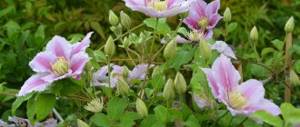Arrowroot, a flowering plant that surprises with the decorativeness of its leaves, seems to be painted with patterns, has gained particular popularity in floriculture. The flower was born in the West Indies and the tropics of South and Central America, and was named in honor of the doctor and botanist B. Maranta.
This exotic flower is suitable for keeping in any room due to its miniature size. Growing this representative of the arrowroot family at home can sometimes cause difficulties for beginners, but if you follow simple rules for caring for the arrowroot plant, it will delight you with bright green leaves all year round.
Characteristics of arrowroot and plant species
The indoor flower is characterized by tuberous roots and ellipse-shaped leaves, which are located on the stems. The color of the leaves is very original and beautiful: depending on the variety, the color can vary from white to rich green. Patterns of stripes and veins are clearly visible on the main color background. The outer part of the leaf blade is brighter and richer in color than the inner part, which is especially visible when the plant lifts and curls its leaves in the evening. For this feature, arrowroot is called a “prayer flower.”
Arrowroot blooms infrequently, even with careful care, and the small inflorescences that appear do not have much decorative value. The inflorescences are spike-shaped and asymmetrical, have a light yellow or white color. The fruits of the plant are contained in a single-seeded capsule. The height of the plant is 30-40 cm, which allows it to be grown in a small room, while arrowroot growing in the wild sometimes reaches 1 m in height.
Good to know!
In their natural environment, flowers grow in the tropical rainforests of South America, which means that the flower cannot survive in dry climates.
You may be interested in:
Growing canna in open ground and at home The beautiful canna plant is quite a heat-loving plant, but if you care for it properly, you can freely...Read more...
Two of them are most often grown indoors: Tricolor (Tricolor) and Bicolor. These species are often confused with each other, but their difference in color is obvious if you look at the photo more closely. There are about 25 species in the arrowroot genus, but several are especially popular:
- A characteristic feature of the Tricolor species is large oval-shaped leaves, which can reach 15 cm in length and 6 cm in width. The outer side of the leaves has an unusual color: around the central light pink vein there are feather-shaped stripes. Their color varies from light to dark green. The inner side of the leaf blade may be pink or purple. The stems reach 30 cm in height, and yellow or white inflorescences may appear from their tops.
Tricolor - Two-color arrowroot has the same parameters, but differs in leaf color, and is less common than tricolor. This species is distinguished by the fact that it does not form a root system. The pattern on the underside of the leaf is reddish, on the top it is dark green.
Arrowroot two-color
- White-veined ornamental arrowroot is another popular species in floriculture, which is characterized by oval leaves with a silver stripe in the center and outer rich green edges. The plant height is standard - 30 cm. This is one of the most unpretentious and beautiful species.
White-veined
- Arrowroot Kerkhoven is an unusual species, the distinctive feature of which is rich green leaves with very dark small spots located around the central vein. Such a plant is usually slightly lower than the species presented above and rarely reaches a height of more than 25 cm.
Maranta Kerkhoven
- Arrowroot Massanja (Black) is a flower that differs from all species in the darkest color of its leaf blades with a thin silver stripe in the center. This variety of arrowroot is very whimsical and is rarely grown at home.
Maranta Massanja
Caring for arrowroot plants at home
Despite the fact that some types of arrowroot are quite whimsical, caring for such species as Bicolor and Tricolor does not cause many problems even for beginners. The main requirement for care is to create conditions as close to natural as possible:
- constant high air humidity;
- average air temperature;
- shaded place without direct sunlight;
- long daylight hours.
Care at home
The main difficulty encountered when growing is the need to maintain moist soil, but at the same time prevent stagnation of moisture in it. To prevent the liquid from stagnating in the soil, you can resort to a simple trick that will create conditions for the flower that are close to those in a greenhouse.
Before spraying the flower, place the pot in a plastic bag, tie it so that the leaves are not covered by it, and then start spraying. Then take out the pot and place it on a tray with wet expanded clay - this will allow you to achieve almost 100% air humidity.
Remember!
The plant needs to be fed, but this can only be done after watering. If you add fertilizer to dry soil, you can burn the roots.
Preference should be given to liquid organic fertilizers, as they are more easily absorbed by plants. Fertilizers for decorative deciduous crops are best suited.
Some difficulties that arise when growing arrowroot and ways to solve them:
- Brown and darkened tips of leaves mean too dry air and soil, poor quality of water used for irrigation. For irrigation, you need to take filtered water at room temperature.
- Yellow or brown tips of the leaves - the plant does not have enough vitamins or, on the contrary, there are too many of them. When using nutrient soil, there is no need to overfeed the plant.
- Pale leaves mean intense light is harmful to this indoor plant.
Lighting
Despite the fact that the plant should be in partial shade, it will die if there is no sunlight for a long time. It is better to place the flower pot in a place where the sunlight is diffused and not too bright: windows facing north will be the most suitable option. You can place the plant on the windowsill of a window facing east and west, but then the flower will have to be shaded.
Lighting
In the warm season, arrowroot can be taken out into the fresh air: into the garden or onto the balcony. You can tell that a plant is suffering from an excess of light by looking at the leaves: if they quickly lose their rich green light and become almost white, the plant needs to be moved into the shade. If the leaves curl and the pattern on them becomes blurred, the arrowroot does not have enough light. Daylight hours are 14-16 hours. You can maintain a normal daily routine for arrowroot in winter using fluorescent lamps.
You may be interested in:
How to care for geraniums in winter? Many women love to grow flowers at home, because it’s not only beautiful, but there’s something to do with their free time....Read more...
Temperature and humidity
For normal flower development at home, it is necessary to maintain an average temperature in the room, both in winter and summer. Temperature changes, too low or too high, should not be allowed.
On a note!
The optimal temperature is 18-25 ˚C. In addition to maintaining temperature, arrowroot needs to provide a flow of fresh air. The room must be ventilated, but drafts are not allowed.
The air in the room with arrowroot should have high humidity, which can be ensured by regularly spraying the flower with filtered water from a spray bottle. Spraying should be frequent but moderate. In summer you need to spray the flower at least twice. In hot weather, arrowroot can be placed near an additional source of moisture - an aquarium or fountain. In summer during the rainy season, the flower grows well outdoors in the shade.
Watering and fertilizing
The soil in which the flower grows must be constantly moist. However, there should not be stagnation of water. By checking the soil moisture with a wooden knitting needle (the soil should dry out by 2 cm), you can water the plant once every 3-4 days in the summer. In winter, watering should be reduced, moistening the soil no more than once a week. For irrigation, soft filtered water is used, which should be warm to avoid hypothermia of the roots.
Watering must be accompanied by fertilizing. Starting in spring, mineral fertilizers should be added to the soil in low concentrations, diluted with 2 times more liquid than indicated in the instructions on the fertilizer package. The frequency of fertilizing is 2 times a month in spring and summer. In autumn, you can also fertilize the plant, but not more than once a month. If the arrowroot has dropped its leaves, there is too much fertilizer in the soil.
Care during the flowering period
At home, arrowroot rarely blooms, and the flowering time is very short. During this short period, the plant is greatly depleted, so many experienced gardeners cut off the flower stalks immediately after they appear. If you want to keep the flower, you need to care for it, adhering to the standard rules: a place in the shade, high humidity and regular watering. It is not necessary to add fertilizers to the soil, especially if the soil is already nutritious.
Diseases and pests
Plants kept in unsuitable conditions are susceptible to diseases and pests. Arrowroot is susceptible to attack by the following insects and diseases:
- Spider mite. Appears when the air in the room is very dry and the temperature is high. To get rid of the insect, air humidity must be increased to normal levels and do not forget to water the flower. It is better to transplant the infected plant into new soil and treat it with acaricides and insectoacaricides.
Spider mite on arrowroot
- Mealybug. Insects can be removed by washing the plant with a soapy solution, then treating with insecticides three times, with an interval of 10 days. Preventing the appearance of scale insects is to maintain normal soil moisture, avoid drafts, and plant the plant in sterile soil.
- Chlorosis. The plant becomes ill due to a lack of iron, which causes the leaves and shoots to dry out and fall off. You can avoid the disease by periodically watering with acidified water (dissolve a few grains of citric acid).
Problems during cultivation
If you care for arrowroot incorrectly, it can get sick. We tried to collect for you the most common symptoms of arrowroot grown at home, and tips on how to return the plant to its healthy appearance.
- The tips of the arrowroot leaves are drying out. This happens if the air in the room is too dry. In this case , the leaves may fall off, and the growth of the plant will stop . Start spraying the plant more often with a spray bottle, place a tray with wet expanded clay, or move the flower to a room with an aquarium.
- The leaves lose their color and become faded. This is how arrowroot reacts to direct sunlight. Create more shade with curtains and move the pot further into the room.
- If the stems and leaves of the arrowroot wither and rot , then most likely you are watering your beauty too much, and with cold water. Reduce watering, use only warm, settled water. If this does not help, remove the plant from the pot and trim off the rotten areas of the root. Treat the cut areas with crushed coal and root formation stimulator. Plant in a new pot with new soil.
- Arrowroot leaves turn yellow and dry, sometimes curling. Frequent exposure of the plant to drafts often leads to this result.
- The arrowroot leaves have stopped rising (the flower is no longer praying). If you have an old copy, then this is normal. If not, it looks like your bush is too crowded in the pot and it’s time to replant it.
- Yellow or light brown spots appear on the leaves. This could be sunburn. Check to see if your arrowroot is exposed to direct sunlight. In addition, inspect the flower for parasites.
This may be interesting: Description of types and varieties of Tradescantia
Pests
- Mealybug. White fluffy lumps appear on the leaves and shoots of arrowroot, under which there is an insect. Arrowroot leaves fade and die. Gently wash off the parasites with a sponge and soapy water. Then spray with Actellik insecticide according to the instructions. Repeat the procedure until the parasites completely disappear from your flower.
- Shield. Brownish growths on the back of the leaves. Gradually they dry out and fall off. Remove scale insects manually with a damp cloth. Treat arrowroot with Fitoverm. Repeat the procedure until the insects stop appearing again.
- Thrips. Small insects and small black dots appear on the back of the leaves. Thrips lay eggs in the ground. Adult insects can be washed off with water. To destroy the larvae, water the soil with Aktara solution once a week for 3-4 weeks.
- Spider mite. Easily recognized by the white cobwebs on the leaves. The leaves lose color and dry out, which is sometimes accompanied by the appearance of reddish spots. Cover the soil with film and bathe the arrowroot in the shower. Then spray the plant with Fitoverm or Derris.
Reproduction and transplantation of arrowroot flowers
Arrowroot can be propagated in two ways: cuttings and dividing the bush. You need to propagate the plant in both ways in the spring:
- When propagating by cuttings, you need to make sure that each shoot has 1-2 leaves, and the length of the cutting is at least 10 cm. The cut cuttings must be placed in water; after 10-14 days they will take root. While the cuttings are standing in water, they also need to be sprayed regularly and kept in a warm room. There is no need to cover them with film.
Cuttings
Cuttings need to be rooted in nutritious soil and watered. While they are developing in the new soil, they cannot be exposed to the sun: they require a shaded place. When the cuttings grow, they can be planted in separate pots and continued to be cared for as for adult plants. - Dividing the bush is a more gentle method. Before dividing, you need to make sure that both parts that need to be divided have a root system and a growing point. Then you need to remove the plant from the soil and use sharp scissors to divide the bush into 2 equal parts. The cut areas at the roots must be treated with crushed coal to prevent them from rotting.
Reproduction of arrowroot by dividing the bush.
The divided parts should be planted in separate pots with nutritious soil for arrowroot and watered with warm water. The pot should be covered with a plastic bag and not removed until the young leaves grow. Subsequent care of the plant is standard.
Remember!
Replanting is especially important for young flowers purchased in a store. It is enough to replant older arrowroots once every 2 years, in the spring (March-May).
Before transplanting, you need to cut off diseased and old leaves and stems to stimulate the growth of new shoots. The new flower pot should be larger and wider than the previous one by a couple of centimeters and have drainage holes. Soil for a houseplant can be purchased at the store or you can make it yourself by mixing the following components in a 2:1:2:1 ratio:
- turf land;
- humus;
- peat;
- wood ash.
You can also add sphagnum moss to the soil, which is a kind of antiseptic for the soil and helps retain moisture in it. The soil should not contain lime - it can destroy the flower. The soil should be light, loose and easily permeable to air. All ingredients must be mixed until smooth in a separate container.
Transfer
The plant must be removed from the old pot along with the soil, and then completely cleaned off from the root system. Place drainage (2-3 cm) and a little crushed polystyrene foam at the bottom of the new pot. Afterwards, you need to pour the soil into the pot, lightly tamping it with your hand. When there is about 4-5 cm of free space left to the top of the pot, place the flower in the soil and sprinkle the roots with the remaining soil. Water the plant with water at room temperature with vitamins dissolved in it.
You may be interested in:
Camellia: home care, diseases, types Camellia is a type of indoor plant that stands out for its luxurious flowers and decorativeness. Such...Read more...
Transfer
Young specimens of arrowroot require replanting every year, and adults once every 3-4 years. It is better to do this after pruning, when all the shoots are cut off. The pot for arrowroot must be made of plastic or clay, covered with glaze, 2-3 cm larger than the previous one. Drainage in the form of pebbles or expanded clay, as well as holes for water drainage, are required.
Bushes purchased in a store require replanting, regardless of the time of year. The substrate in which they are stored is only suitable for temporary storage on shelves and transportation. The plant will not grow and develop in it.
The soil for arrowroot should be loose, soft and light. You can buy ready-made soil for arrowroot in the store, or you can prepare the soil mixture yourself. To do this, use the following ingredients:
- 3 parts leaf soil;
- 1.5 parts peat;
- 1 part each of coniferous soil, sand and dry mullein;
- 0.3 parts ash.
This may be interesting: Syngonium - home care
Transplantation is carried out by transferring a clod of earth from one pot to another. To quickly root and retain moisture, the pot can be temporarily covered with film. In the first month after transplantation, arrowroot does not need to be fertilized.
Signs and superstitions about indoor plants
Maranta is not only a wonderful decoration for any home, but also a real talisman that attracts prosperity and happiness. According to signs, the plant contributes to the financial well-being of its owners, so the best place to place it would be an office or workplace. It is believed that if buds appear on the plant, the owner will soon receive a large sum of money. Buds on a plant may also indicate that a child will soon be born in the family. Since arrowroot is rarely covered with flowers, such signs are often considered fair.
The flower is often placed in living rooms: arrowroot acts as the guardian of the hearth, helps to avoid conflicts in the family and strengthen the relationship between spouses. It will be useful to put a flower in the room of a child who often has problems with sleep and study. A flower placed in a nursery normalizes sleep patterns, promotes concentration and improves the psychological situation.
Arrowroot helps improve the well-being of people of all ages, so it is useful to care for the flower for older people with health problems.
In such cases, it is better to place the flower at the head of the bed. Most signs about arrowroot have a positive attitude, but there is one negative superstition - the death of a flower can mean that a misfortune will soon occur in the family. However, given that the flower is unpretentious and caring for it is quite simple, the plant does not die with good care.
You may be interested in:
Caring for indoor codium flowers at home (26 photos) Codium is a very beautiful decorative foliage plant. Despite the fact that codiaum is capable of blooming, it...Read more...
Is it possible to keep arrowroot at home?
Most signs about Marantaceae are favorable, so keeping the plant in the house is possible and necessary. But for it to take care of the physical and emotional health of your loved ones, you need to find the right place to place it. In addition to favorable signs, arrowroot has a number of valuable qualities. The roots are added to food for various diseases; the tubers contain vitamins B9, PP, and pantothenic acid.
Sometimes arrowroot in the house can cause harm. The leaves should not be taken orally uncontrollably without consulting a doctor due to individual intolerance. Taking flour from the plant is contraindicated for stomach ulcers and after surgery.
For favorable signs to work, it is important to properly care for arrowroot.
- The temperature is not lower than 25 degrees.
- Good lighting (in dim light, you can place a lamp next to the flower).
- Watering in spring and summer every 2 days.
- Feed every 2-3 weeks.
Where is the best place to put the plant?
According to signs, arrowroot will protect the family, bring good luck and prosperity if placed in the corner of the room. But for a tropical guest to attract happiness, she needs a sufficient amount of sunlight. It will also enrich the person in whose room it will stand. Therefore, it is advisable to place the flower where the family spends more time, for example, in the living room or kitchen.
Currently viewing → Signs and superstitions about “Women’s Happiness”
Thanks to its positive signs and its beauty, arrowroot is a mandatory decorative element in almost every home in China.
Also, prayer grass is placed in the study, children's room and bedroom, next to the bed. Maranths strengthen family relationships and improve the intimate life of spouses.
Common questions about growing flowers
Why do the stems become soft and rot?
If the arrowroot stems are in this condition, then the plant is rotting. This happens in winter if the air temperature is very low and watering is abundant. The plant can be saved by replanting it in new soil only if no more than 40% of its surface is damaged.
Which propagation method is best for a beginner to use?
Beginner flower growers are better off using the method of dividing the bush. This method is gentle on these plants and does not require the skills to carefully care for the transplanted flower. The main thing is to work carefully, with clean garden tools, without damaging the roots. If the root does break during transplantation, the broken area must be treated with crushed coal. However, if cut shoots remain after shaping, you can propagate the flower with them, so as not to further injure the plant.
How to painlessly shape a flower?
In order for the flower to continue to grow normally after pruning, it is necessary to remove only those shoots that look weak, unproductive, or directed inward. When forming a houseplant, you can cut off 2/3 of the shoot, while focusing on the total amount of foliage. This procedure is best carried out in the spring.
Is it possible to spray leaves in winter?
In winter, you need to spray the leaves, as during the heating season the air in the room becomes drier. Spraying can be alternated with wiping with a damp sponge.
Caring for arrowroot is quite simple: it is resistant to disease and easily tolerates a lack of light. If you follow the main rule - maintaining moist air and soil - the flower will be healthy and strong. If you have one developed arrowroot in your home greenhouse, you can get several more young flowers using simple plant propagation tips.
Arrowroot, a flowering plant that surprises with the decorativeness of its leaves, seems to be painted with patterns, has gained particular popularity in floriculture. The flower was born in the West Indies and the tropics of South and Central America, and was named in honor of the doctor and botanist B. Maranta.
This exotic flower is suitable for keeping in any room due to its miniature size. Growing this representative of the arrowroot family at home can sometimes cause difficulties for beginners, but if you follow simple rules for caring for the arrowroot plant, it will delight you with bright green leaves all year round.
Characteristics of arrowroot and plant species
The indoor flower is characterized by tuberous roots and ellipse-shaped leaves, which are located on the stems. The color of the leaves is very original and beautiful: depending on the variety, the color can vary from white to rich green. Patterns of stripes and veins are clearly visible on the main color background. The outer part of the leaf blade is brighter and richer in color than the inner part, which is especially visible when the plant lifts and curls its leaves in the evening. For this feature, arrowroot is called a “prayer flower.”
Arrowroot blooms infrequently, even with careful care, and the small inflorescences that appear do not have much decorative value. The inflorescences are spike-shaped and asymmetrical, have a light yellow or white color. The fruits of the plant are contained in a single-seeded capsule. The height of the plant is 30-40 cm, which allows it to be grown in a small room, while arrowroot growing in the wild sometimes reaches 1 m in height.
Good to know!
In their natural environment, flowers grow in the tropical rainforests of South America, which means that the flower cannot survive in dry climates.
You may be interested in:
Growing canna in open ground and at home The beautiful canna plant is quite a heat-loving plant, but if you care for it properly, you can freely...Read more...
Two of them are most often grown indoors: Tricolor (Tricolor) and Bicolor. These species are often confused with each other, but their difference in color is obvious if you look at the photo more closely. There are about 25 species in the arrowroot genus, but several are especially popular:
- A characteristic feature of the Tricolor species is large oval-shaped leaves, which can reach 15 cm in length and 6 cm in width. The outer side of the leaves has an unusual color: around the central light pink vein there are feather-shaped stripes. Their color varies from light to dark green. The inner side of the leaf blade may be pink or purple. The stems reach 30 cm in height, and yellow or white inflorescences may appear from their tops. Tricolor
- Two-color arrowroot has the same parameters, but differs in leaf color, and is less common than tricolor. This species is distinguished by the fact that it does not form a root system. The pattern on the underside of the leaf is reddish, on the top it is dark green. Arrowroot two-color
- White-veined ornamental arrowroot is another popular species in floriculture, which is characterized by oval leaves with a silver stripe in the center and outer rich green edges. The plant height is standard - 30 cm. This is one of the most unpretentious and beautiful species. White-veined
- Arrowroot Kerkhoven is an unusual species, the distinctive feature of which is rich green leaves with very dark small spots located around the central vein. Such a plant is usually slightly lower than the species presented above and rarely reaches a height of more than 25 cm. Maranta Kerkhoven
- Arrowroot Massanja (Black) is a flower that differs from all species in the darkest color of its leaf blades with a thin silver stripe in the center. This variety of arrowroot is very whimsical and is rarely grown at home. Maranta Massanja
Caring for arrowroot plants at home
Despite the fact that some types of arrowroot are quite whimsical, caring for such species as Bicolor and Tricolor does not cause many problems even for beginners. The main requirement for care is to create conditions as close to natural as possible:
- constant high air humidity;
- average air temperature;
- shaded place without direct sunlight;
- long daylight hours.
Care at home
The main difficulty encountered when growing is the need to maintain moist soil, but at the same time prevent stagnation of moisture in it. To prevent the liquid from stagnating in the soil, you can resort to a simple trick that will create conditions for the flower that are close to those in a greenhouse.
Before spraying the flower, place the pot in a plastic bag, tie it so that the leaves are not covered by it, and then start spraying. Then take out the pot and place it on a tray with wet expanded clay - this will allow you to achieve almost 100% air humidity.
Remember!
The plant needs to be fed, but this can only be done after watering. If you add fertilizer to dry soil, you can burn the roots.
Preference should be given to liquid organic fertilizers, as they are more easily absorbed by plants. Fertilizers for decorative deciduous crops are best suited.
Some difficulties that arise when growing arrowroot and ways to solve them:
- Brown and darkened tips of leaves mean too dry air and soil, poor quality of water used for irrigation. For irrigation, you need to take filtered water at room temperature.
- Yellow or brown tips of the leaves - the plant does not have enough vitamins or, on the contrary, there are too many of them. When using nutrient soil, there is no need to overfeed the plant.
- Pale leaves mean intense light is harmful to this indoor plant.
Lighting
Despite the fact that the plant should be in partial shade, it will die if there is no sunlight for a long time. It is better to place the flower pot in a place where the sunlight is diffused and not too bright: windows facing north will be the most suitable option. You can place the plant on the windowsill of a window facing east and west, but then the flower will have to be shaded.
Lighting
In the warm season, arrowroot can be taken out into the fresh air: into the garden or onto the balcony. You can tell that a plant is suffering from an excess of light by looking at the leaves: if they quickly lose their rich green light and become almost white, the plant needs to be moved into the shade. If the leaves curl and the pattern on them becomes blurred, the arrowroot does not have enough light. Daylight hours are 14-16 hours. You can maintain a normal daily routine for arrowroot in winter using fluorescent lamps.
You may be interested in:
How to care for geraniums in winter? Many women love to grow flowers at home, because it’s not only beautiful, but there’s something to do with their free time....Read more...
Temperature and humidity
For normal flower development at home, it is necessary to maintain an average temperature in the room, both in winter and summer. Temperature changes, too low or too high, should not be allowed.
On a note!
The optimal temperature is 18-25 ˚C. In addition to maintaining temperature, arrowroot needs to provide a flow of fresh air. The room must be ventilated, but drafts are not allowed.
The air in the room with arrowroot should have high humidity, which can be ensured by regularly spraying the flower with filtered water from a spray bottle. Spraying should be frequent but moderate. In summer you need to spray the flower at least twice. In hot weather, arrowroot can be placed near an additional source of moisture - an aquarium or fountain. In summer during the rainy season, the flower grows well outdoors in the shade.
Watering and fertilizing
The soil in which the flower grows must be constantly moist. However, there should not be stagnation of water. By checking the soil moisture with a wooden knitting needle (the soil should dry out by 2 cm), you can water the plant once every 3-4 days in the summer. In winter, watering should be reduced, moistening the soil no more than once a week. For irrigation, soft filtered water is used, which should be warm to avoid hypothermia of the roots.
Watering must be accompanied by fertilizing. Starting in spring, mineral fertilizers should be added to the soil in low concentrations, diluted with 2 times more liquid than indicated in the instructions on the fertilizer package. The frequency of fertilizing is 2 times a month in spring and summer. In autumn, you can also fertilize the plant, but not more than once a month. If the arrowroot has dropped its leaves, there is too much fertilizer in the soil.
Care during the flowering period
At home, arrowroot rarely blooms, and the flowering time is very short. During this short period, the plant is greatly depleted, so many experienced gardeners cut off the flower stalks immediately after they appear. If you want to keep the flower, you need to care for it, adhering to the standard rules: a place in the shade, high humidity and regular watering. It is not necessary to add fertilizers to the soil, especially if the soil is already nutritious.
Diseases and pests
Plants kept in unsuitable conditions are susceptible to diseases and pests. Arrowroot is susceptible to attack by the following insects and diseases:
- Spider mite. Appears when the air in the room is very dry and the temperature is high. To get rid of the insect, air humidity must be increased to normal levels and do not forget to water the flower. It is better to transplant the infected plant into new soil and treat it with acaricides and insectoacaricides. Spider mite on arrowroot
- Mealybug. Insects can be removed by washing the plant with a soapy solution, then treating with insecticides three times, with an interval of 10 days. Preventing the appearance of scale insects is to maintain normal soil moisture, avoid drafts, and plant the plant in sterile soil.
- Chlorosis. The plant becomes ill due to a lack of iron, which causes the leaves and shoots to dry out and fall off. You can avoid the disease by periodically watering with acidified water (dissolve a few grains of citric acid).
Indoor air humidity
Like any native of the tropics, arrowroot prefers conditions similar to the climatic features of its natural habitat. The air humidity is no exception, which should be as high as you can achieve. Throughout the year, arrowroot must be sprayed daily with soft water. In winter, when heating systems are operating in the rooms, it is recommended to spray arrowroot twice a day - in the morning and in the evening.
This may be interesting: Monstera - caring for a beauty with a scary name
In summer, it is advisable to give the plant a warm shower, but the pot should be covered with film to prevent water from getting into the soil. To further increase humidity, place the flower pot on a tray with wet expanded clay or pebbles. Make sure that the roots do not come into contact with moisture, as it will cool and prevent the soil from drying out, and, as we said earlier, arrowroot does not tolerate low temperatures and swamps in the ground.
Reproduction and transplantation of arrowroot flowers
Arrowroot can be propagated in two ways: cuttings and dividing the bush. You need to propagate the plant in both ways in the spring:
- When propagating by cuttings, you need to make sure that each shoot has 1-2 leaves, and the length of the cutting is at least 10 cm. The cut cuttings must be placed in water; after 10-14 days they will take root.
While the cuttings are standing in water, they also need to be sprayed regularly and kept in a warm room. There is no need to cover them with film. Cuttings Cuttings need to be rooted in nutritious soil and watered. While they are developing in the new soil, they cannot be exposed to the sun: they require a shaded place. When the cuttings grow, they can be planted in separate pots and continued to be cared for as for adult plants. - Dividing the bush is a more gentle method.
Before dividing, you need to make sure that both parts that need to be divided have a root system and a growing point. Then you need to remove the plant from the soil and use sharp scissors to divide the bush into 2 equal parts. The cut areas at the roots must be treated with crushed coal to prevent them from rotting. Reproduction of arrowroot by dividing the bush. The divided parts should be planted in separate pots with nutritious soil for arrowroot and watered with warm water. The pot should be covered with a plastic bag and not removed until the young leaves grow. Subsequent care of the plant is standard.
Remember!
Replanting is especially important for young flowers purchased in a store. It is enough to replant older arrowroots once every 2 years, in the spring (March-May).
Before transplanting, you need to cut off diseased and old leaves and stems to stimulate the growth of new shoots. The new flower pot should be larger and wider than the previous one by a couple of centimeters and have drainage holes. Soil for a houseplant can be purchased at the store or you can make it yourself by mixing the following components in a 2:1:2:1 ratio:
- turf land;
- humus;
- peat;
- wood ash.
You can also add sphagnum moss to the soil, which is a kind of antiseptic for the soil and helps retain moisture in it. The soil should not contain lime - it can destroy the flower. The soil should be light, loose and easily permeable to air. All ingredients must be mixed until smooth in a separate container.
Transfer
The plant must be removed from the old pot along with the soil, and then completely cleaned off from the root system. Place drainage (2-3 cm) and a little crushed polystyrene foam at the bottom of the new pot. Afterwards, you need to pour the soil into the pot, lightly tamping it with your hand. When there is about 4-5 cm of free space left to the top of the pot, place the flower in the soil and sprinkle the roots with the remaining soil. Water the plant with water at room temperature with vitamins dissolved in it.
You may be interested in:
Camellia: home care, diseases, types Camellia is a type of indoor plant that stands out for its luxurious flowers and decorativeness. Such...Read more...
Signs and superstitions about indoor plants
Maranta is not only a wonderful decoration for any home, but also a real talisman that attracts prosperity and happiness. According to signs, the plant contributes to the financial well-being of its owners, so the best place to place it would be an office or workplace. It is believed that if buds appear on the plant, the owner will soon receive a large sum of money. Buds on a plant may also indicate that a child will soon be born in the family. Since arrowroot is rarely covered with flowers, such signs are often considered fair.
The flower is often placed in living rooms: arrowroot acts as the guardian of the hearth, helps to avoid conflicts in the family and strengthen the relationship between spouses. It will be useful to put a flower in the room of a child who often has problems with sleep and study. A flower placed in a nursery normalizes sleep patterns, promotes concentration and improves the psychological situation.
Arrowroot helps improve the well-being of people of all ages, so it is useful to care for the flower for older people with health problems.
In such cases, it is better to place the flower at the head of the bed. Most signs about arrowroot have a positive attitude, but there is one negative superstition - the death of a flower can mean that a misfortune will soon occur in the family. However, given that the flower is unpretentious and caring for it is quite simple, the plant does not die with good care.
You may be interested in:
Caring for indoor codium flowers at home (26 photos) Codium is a very beautiful decorative foliage plant. Despite the fact that codiaum is capable of blooming, it...Read more...
Is arrowroot poisonous?
The plant is a remedy for most diseases. That’s why praying herb is still used for medicinal purposes. Scientific studies have shown that arrowroot does not cause allergies, does not emit toxic fumes, and its juice is not poisonous. Therefore, she can live side by side with small children and pets. The same cannot be said about such indoor beauties as Dieffenbachia and Croton.
Currently viewing → Signs and superstitions about the Eucharis flower











